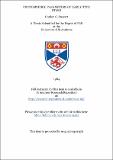Photospheric parameters of early-type stars
Abstract
The development of an interactive data reduction and analysis system for astronomical spectra written in the FORTH computing language and operated on the Nova 820 minicomputer at the University Observatory, St. Andrews is discussed. Spectra of a number of B stars, many of which were obtained by the author at the South African Astronomical Observatory, were measured and reduced using this system. Equivalent widths of metal absorption lines are used to deduce the stars' fundamental photospheric parameters and abundances by comparison with the predictions of both non-LTE and line-blanketed LTE models. It is shown that effective temperatures derived with the line-blanketed LTE models are in good agreement with those found by other authors for near main sequence B stars using measurements of the integrated flux of the stars. Unblanketed non-LTE models give effective temperatures which are systematically high by approximately 7%, similar to the difference between blanketed and unblanketed LTE models. The major differences between the predictions for absorption lines using LTE and non-LTE models are due to the different level populations predicted and not to the different photospheric structures. The use of non-LTE models is found to reduce the microturbulence required to bring element abundances derived from strong lines into agreement with those found for weak lines but not to remove the need for the inclusion of microturbulence in the solutions for most B stars. An investigation of the suitability of the analysis of high resolution Michelson interferometry using Fourier decomposition techniques as a means of determining the broadening mechanisms and velocity fields in the photospheres of early A stars is made.
Type
Thesis, PhD Doctor of Philosophy
Collections
Items in the St Andrews Research Repository are protected by copyright, with all rights reserved, unless otherwise indicated.

